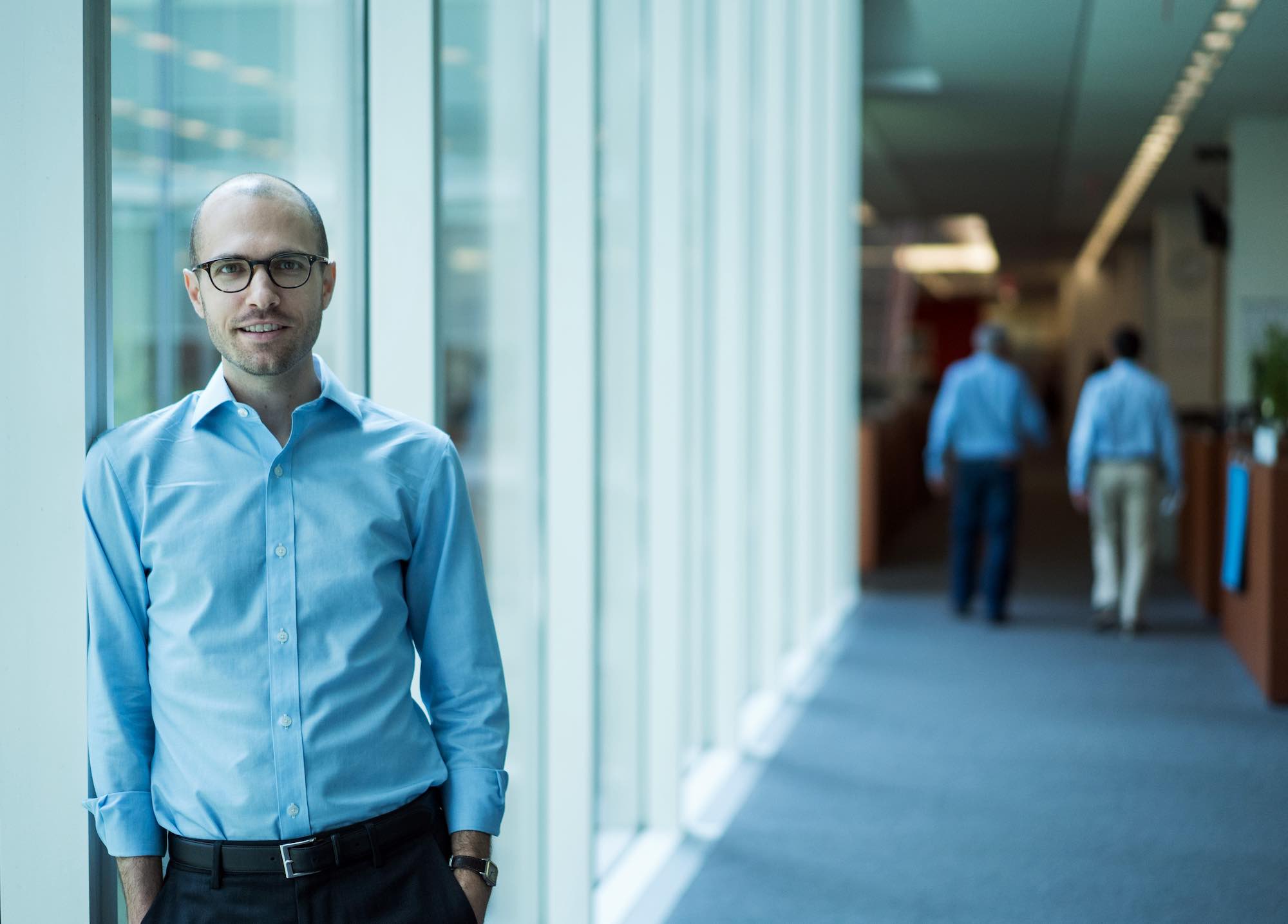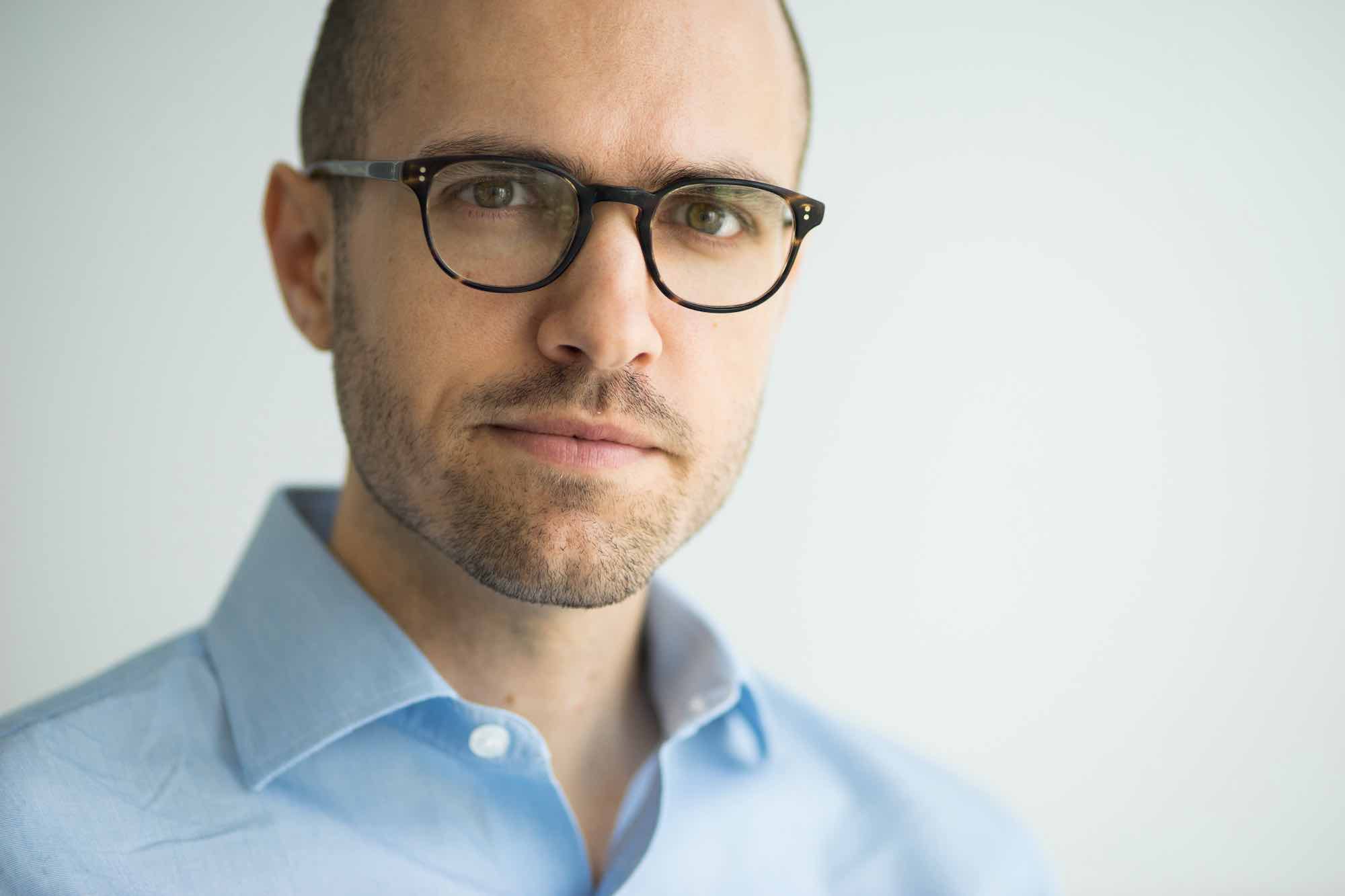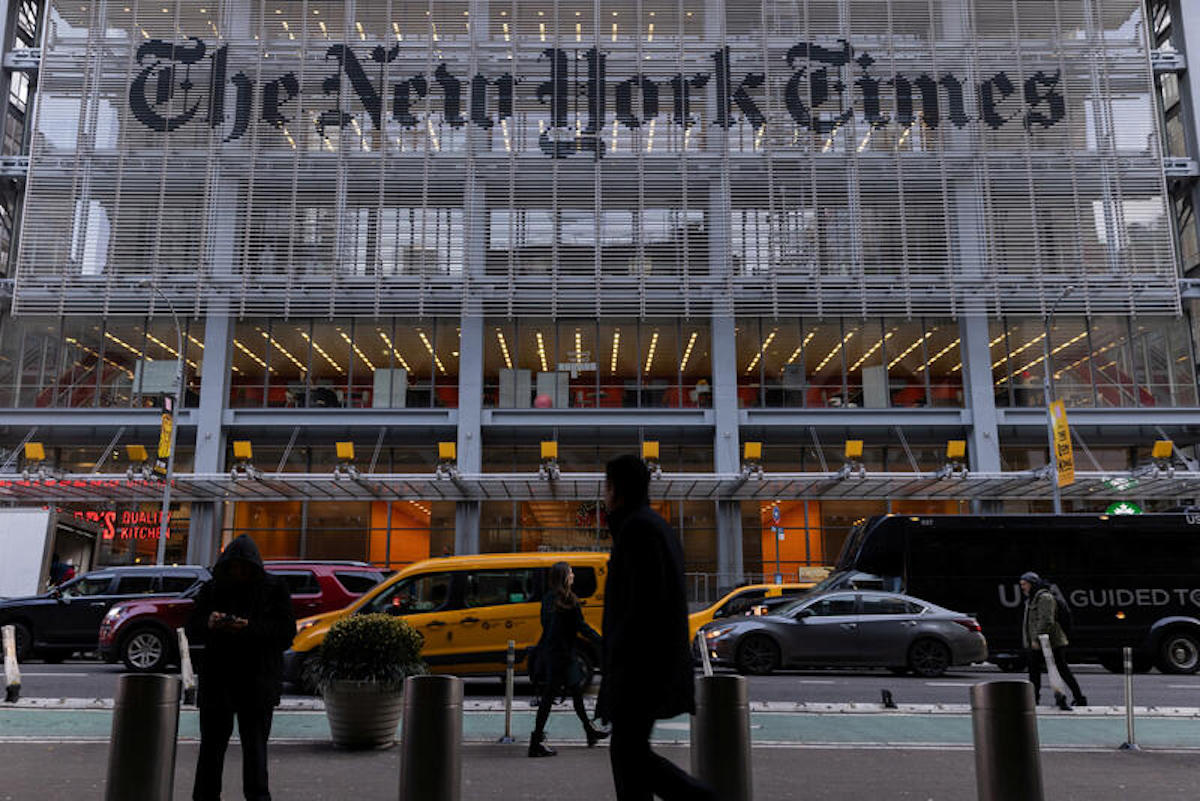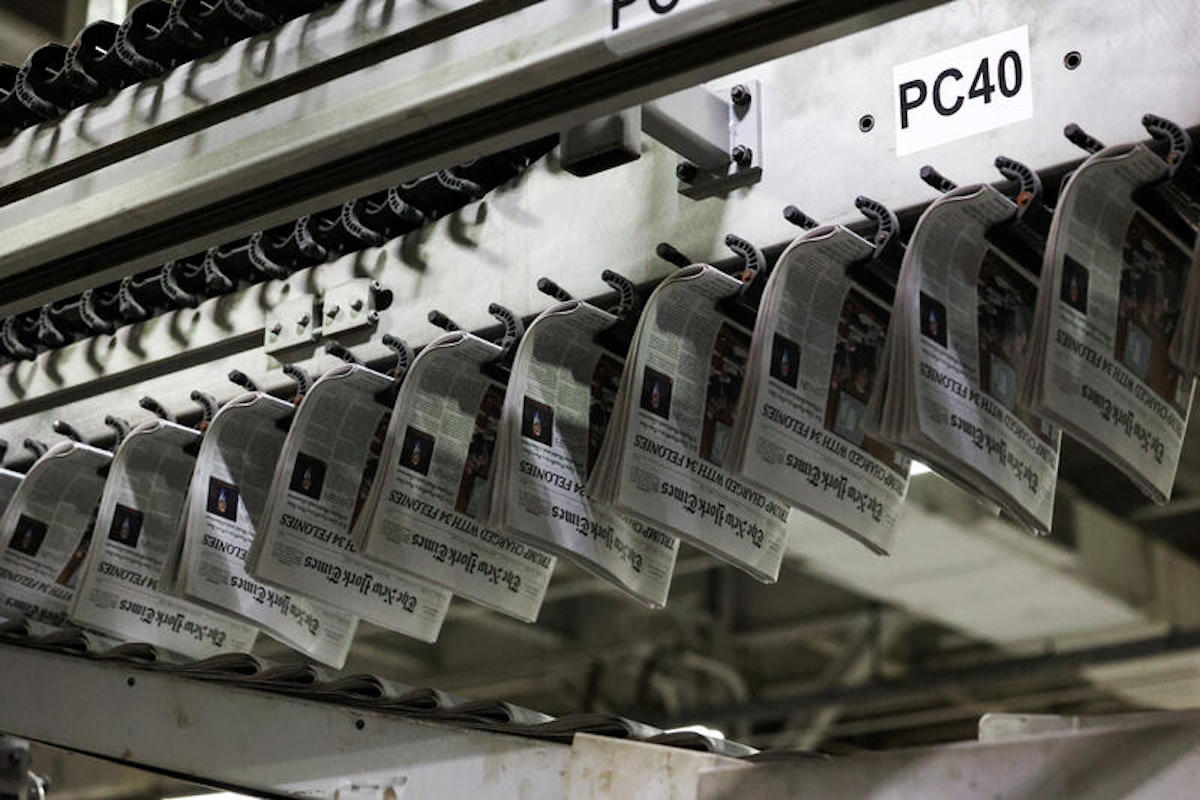New York Times publisher A. G. Sulzberger: “Our industry needs to think bigger”

New York Times publisher A. G. Sulzberger. | Credit: New York Times
In early January 1996 journalist Kevin McKenna presented the New York Times’ first website to three generations of the Sulzberger family: the publisher Arthur Ochs Sulzberger Jr., his father and predecessor, and his eldest son, Arthur Gregg Sulzberger, who would succeed him in 2018 and who was 15 years old at the time.
McKenna was part of a four-member committee that had been working for a year on different prototypes of the website, which would go live a few days later. According to a new history of the Times by journalist Adam Nagourney, the youngest Sulzberger asked McKenna whether the new site would be updated with late-night scores from the games of the Seattle SuperSonics – those results that often came in too late to make the deadline for the morning newspaper. He responded it would.
Almost three decades later, the teenager who asked that question is at the top of the masthead of a news organisation with almost 10 million digital subscribers. Sulzberger, now 43, is the sixth member of his family to serve as publisher since the newspaper was purchased by Adolph Ochs in 1896.
Before taking this role, Sulzberger worked as a reporter for two local newspapers and wrote more than 350 pieces for the Times from New York and the American Midwest. In 2014 he authored the Innovation Report, a hundred-page document that spearheaded digital change at the paper. Four years later, he succeeded his father as publisher.
On 4 March Arthur Gregg Sulzberger was in Oxford to deliver the 2024 Reuters Memorial Lecture, the main event the Reuters Institute hosts every year. He followed in the footsteps of distinguished speakers such as Carlos F. Chamorro, Alessandra Galloni, Patrícia Campos Mello, Rebecca Corbett, Siddharth Varadarajan, Marty Baron, Melissa Bell and his own father, who delivered the lecture in 2008.
I recently spoke to Sulzberger in an hour-long video call, and asked him a couple of follow-up questions by email. This piece, based on that interview, focuses on three main themes: his career, his company’s business and his newspaper’s editorial values. Our conversation has been lightly edited for clarity and length.
Lee esta entrevista en español | Read our summary with 11 key quotes
Jump to Sulzberger's views on: the Innovation Report | layoffs in US newspapers | editorial independence | the Times' coverage of Gaza | covering Trump | the Times' opinion section | the rise of generative AI

I. Becoming the publisher.
Arthur Gregg Sulzberger was born in Washington on 5 August 1980. His name first appeared in the New York Times a day later in a short piece in the metropolitan section.
Despite his family background, he wanted to pursue a career outside journalism, perhaps as an environmentalist or a political campaigner. But this changed after he took a feature writing class at Brown University with Tracy Breton, an investigative journalist from the Providence Journal.
According to this insightful profile, the young Sulzberger fell in love with the clarity and precision of newspaper writing, and Breton urged him to apply for a two-year internship at the Journal. Many years later, Sulzberger still recalled her pitch: “She said: ‘Look, you’re good at this, you like it, and you should give it a shot. If it turns out it’s not for you, then you’ll have answered a big question that otherwise might hang over you in your life.’”
At the Journal Sulzberger covered the small coastal town of Narragansett and was offered to stay. But he preferred to move to Portland and take a job at The Oregonian, where he published several exclusive stories, including a series on a sheriff who had lied about an affair with the governor’s wife.
In 2009 Sulzberger got a call from then-managing editor Jill Abramson, who wanted to recruit him for the Times. He demurred at first, but then accepted and published his first news story at the newspaper under the new byline of A. G. Sulzberger, as his full name was too long to fit into a news column.
A year later, he moved to Kansas City, from where he reported extensively on oil fields, rural decay, and abortion politics, and even wrote a piece about the challenges of being a vegetarian in the Midwest.
In this interview with one of his former colleagues at The Oregonian, Sulzberger recalled a conversation with a farmer while reporting this piece on the impact of storms in South Dakota. After introducing himself as a reporter from the Times, the farmer told him: “My friends on talk radio have told me not to trust you.” To which he responded: “When was the last time your friends on talk radio showed up at your farm in an effort to understand what you’re going through?”
As he faced the final years as publisher, Arthur Sulzberger Jr. thought it was time for his son to return to New York. Abramson, by then the Times’ top editor, joined A. G. in Iowa for the 2012 presidential caucuses and told him it was time to come back.
In her book Merchants of Truth, she describes the young Sulzberger as a shy man, a little ill at ease in New York social life. She had regular meals or drinks with him and remembers him as someone who quoted entire paragraphs of articles from colleagues, a person “endlessly curious, a true student of the news report.”
In 2013 Abramson turned to him to lead a ten-member team to think about new digital offerings. In his notes for a meeting with her, Sulzberger described the project as “a full assault, old school deep dive on our own paper and our own industry.” Halfway through his work, he asked Abramson to change the project’s mission. “I don’t think our focus should be new products. I think we need to focus on the core,” she recalls him telling her.
Sulzberger and his colleagues interviewed hundreds of people and prepared a document that vividly described the challenges faced by his newspaper in the digital world. “The New York Times is winning at journalism,” the report said. “At the same time, we are falling behind in a second critical area: the art and science of getting our journalism to readers.”
The report was presented internally on 24 March 2014 and leaked to Buzzfeed two months later. It was Sulzberger’s first incursion into the business side of the newspaper, and he approached it as the reporter he was. So that is a good place to start.
Q. What do you miss the most about being a reporter?
A. So much. Reporting has this magical balance of learning and teaching. It puts you out in the world talking to people, soaking in the complexity of the world and engaging with the forces shaping it. And then it puts you in this more solitary, creative process of figuring out the best way to share what you’ve learned. It’s a fundamentally idealistic calling, much more so than most people realise, with a really strong orientation towards public service. I couldn’t have asked for a better foundation for my current role.
Q. The Innovation Report, which you authored 10 years ago, was at its core a reporting project. How useful was that exercise for you as a future manager?
A. As you said, I viewed it first and foremost as a reporting project. I didn't know anything about digital. I was sort of proudly ignorant of the ways that the Internet and this social media ecosystem were challenging and changing our industry. So I did the only thing I really knew how to do, which was to ask a bunch of people who are smarter than me on the topic and ask them questions about it.
The path forward in any period of giant transformation is always asking questions, and being sceptical of the answers, and really not believing in any silver bullets

Q. What did you learn about the Times that you didn’t know before you started?
A. A few important lessons. Our work really underscored how important it is that good ideas can rise up in an organisation. At the time we were this old institution earnestly trying to figure out how to adapt. But somehow all these people with great ideas for that weren’t being heard. And because they weren’t being heard, they were leaving for our competitors. So that insistence on hearing from the ground up is something that I have leaned heavily on.
Another learning is just that instinct to report out a question. I remember being struck in that period that there were two categories of news executives trying to figure out success in a digital environment. Category one was the group that would go to the digital conferences and ask everyone, “What should we be doing?” Category two was the very confident set, saying the future of journalism is X or Y.
And I came to believe that the path forward in any period of giant transformation is always asking questions, and being sceptical of the answers, and really not believing in any silver bullets. There’s some insight that each person has gotten to. But it’s a mistake to view this as a holistic solution to a very complicated problem.
We’ve really worked hard not to ever have a pivot at the New York Times. And instead, we’ve worked really hard to cobble together a collection of insights that integrate into an increasingly complex operation. And why is it increasingly complex? Because the ways people are engaging with journalism are increasingly complex.
Q. Looking back at 2014, anything you think the Innovation Report got wrong or not exactly right?
A. Oh, so many things! But I always thought the Innovation Report was misunderstood.
Q. How?
A. People thought it was a document staring into the future. But it was a culture document and it was just about trying to create the conditions for people to stop saying no to change. There were many things I got wrong. The biggest, I suspect, is that we oscillated too far towards social media. But we were coming from a position of institutional arrogance, where we thought we didn’t really have to take social media seriously, and we had to be there because that’s where our future readers were.
We are going to meet our readers first off platform. But we now know these are powerful companies. They dominate the flow of traffic and engagement in the digital world. You need to be on them, and to find ways to partner with them, but your interests are not aligned. You should be clear-eyed on that, treat this as a professional partnership and make sure it meets clearly articulated standards.
Tech platforms are powerful companies. They dominate the flow of traffic and engagement in the digital world. You need to be on them, and to find ways to partner with them, but your interests are not aligned

Q. If you were writing an Innovation Report today, what would be your focus? Which organisations can the New York Times learn from?
A. We try to learn from everyone and everyone tries to learn from us, too. Journalism faces existential pressure right now. But one of the good things that’s emerged from this pressure is that we all trade notes.
Who are we looking at? It’s a very broad swath of journalistic organisations. But I also spend a lot of time looking at non-journalistic media organisations because our industry underestimates how shared the dynamics we all face are.
I’ll just give you an example. A broadly held conception is that our subscription growth came as a result of the election of Donald Trump. I have a different diagnosis. I think it happened disproportionately because of Netflix and Spotify. They had just spent five years convincing the global public that it was okay to pull out your credit card to pay for a service rather than goods.
Trump’s election was an activating moment, where a whole bunch of people who were comfortable doing that said to themselves: “Wow, that seems like a big deal. I should probably be paying attention to the news.” But look at the other great surges of subscriber interest. It's similar moments where people felt like the world needed to be understood, like COVID-19 or the war in Ukraine.

II. A thriving business.
In November 2008, David S. Perpich, a young member of the Sulzberger family who now serves as the publisher of The Athletic, saw a piece on the metered paywall that the FT had launched the year before. This was an innovative paywall that treated the newspaper’s most loyal readers differently from casual visitors who would never subscribe.
“I truly believe this is the model of the future and I think [we] could pull off some version of this,” he wrote on a note he shared with the company’s Vice Chairman Michael Golden.
It was not the first time the Times followed the reader revenue route. In September 2005 the company launched Times Select, its first real effort to make people pay for news online. Digital subscribers paid $49.95 a year to read the Times’ columnists and to access 100 articles from the archives. Print subscribers didn’t pay an additional fee.
The project reached 227,000 paid subscribers and generated $10 million a year in revenue. Tom Friedman and other columnists hated it as it made them lose most of their audience overnight and The Times shut it down in September 2007. As more readers started coming to the site from search engines, the company thought advertising revenue was a safer bet.
But the debate over pay was far from settled, especially in the light of the company’s finances. With its stock plummeting from $53 a share in June 2002 to $3.44 in February 2009, the Times was forced to borrow $250 million from Mexican billionaire Carlos Slim. At the worst of the financial crisis, the newspaper went through several rounds of layoffs as print revenues shrank.
This gave Perpich’s suggestion a clear sense of urgency and pushed the Times to launch its own metered paywall on 28 March 2011.
In the beginning, pundits were not impressed. Media critic Jeff Jarvis wrote in his influential blog: “Why charge your best customers? Why single them out? Why risk driving them away? The logic eludes me. So do the economics.” Business columnist Felix Salmon predicted the new paywall wouldn’t even “cover its own development costs for a good two years” and bet it wouldn’t reach 300,000 subscribers before 2013.
McKinsey, the consulting firm advising the Times on the project, set up a ceiling of 650,000 digital subscribers for the new venture. But the numbers surprised even the most optimistic managers. The Times reached 390,000 digital subscribers by the end of 2011. It has almost 10 million today.
The day before I spoke to Sulzberger, the New York Times Company presented its earnings for the latest quarter of 2023. For the first time, annual revenue for digital subscriptions pushed above $1 billion. Operating profit and average revenue per user were significantly higher than the year before.
The Times is now pushing an all-access digital bundle that includes Games, Audio, Cooking, product reviews site The Wirecutter and sports site The Athletic alongside its general interest journalism. At the end of 2023, almost half of the Times’ digital-only subscribers paid for the whole bundle or for more than one of these products. But the company has set an ambitious goal for the next few years. So that’s what I asked Sulzberger first when we turned to the business side.
Q. The Times’ goal is reaching 15 million subscribers by 2025. Where are you more likely to find them?
A. I think it’s really dangerous for an independent general interest news organisation to chase a particular audience segment. That mindset leads one to distort coverage, especially in this highly polarised moment. Winning over a group too often means showing deference to that group’s narrative, and if an independent organisation does that, it’s the most damaging thing that they can do.
So we don’t think about the audience in that way. We try to offer the very best journalism in a bunch of broadly important topics like the war in Ukraine, the conflict in Gaza, the US elections, human rights in China and India… These are not necessarily all trending topics, but they are important. We do have a lot of confidence that the public wants to be confronted not with the information they think they want but with the information they didn’t know they wanted.
My grandfather had this old line: “When you buy the New York Times, you’re not buying news; you’re buying judgement.” That judgement is a really important part of our promise.
And then, on the other hand, we are trying to win in a handful of big spaces. Our sports coverage is coming from The Athletic, which we think is the largest newsroom of sports journalists in the world, certainly in the English language. So we’re not chasing a particular demographic, beyond people interested in sports, which is a pretty broad swath of planet Earth.
It’s really dangerous for an independent general interest news organisation to chase a particular audience segment. That mindset leads one to distort coverage, especially in this highly polarised moment

Q. Your strategy focuses on the bundle. But I wonder if you would be willing to go further and add more elements to the bundle. For example, a Times subscription with a local title or with a foreign national title; or perhaps buying a niche site such as The Information to cover technology more deeply.
A. I am always open to great ideas, and so don’t want to close anything off. But I find it more valuable to double down on what we are doing than to put too many irons in the fire.
I don’t think the number of spaces that are worth that level of giant intervention like The Athletic is unlimited. At our core, we should be providing the world’s best general interest news product, a product that is really focused on helping anyone who wants to be an engaged global citizen understand the breadth of the world, and the forces, people and ideas shaping it. That’s our core promise.
And then around that, we’ve been really lucky to be able to build a handful of things that tap into people’s passions or everyday needs in a supportive way that deepens the relationship and increases loyalty. I don’t think it’s a radical strategy. It’s really similar to what newspapers used to be.
Young people can’t believe that a newspaper is how you found out who won last night’s game, what was on TV, how stocks were doing and (the one that most boggles their minds)... whether it was going to rain! We are trying to rebuild that sense of being a full service restaurant to some extent.
Q. Your new audio app features audio versions of articles from other publications such as Foreign Policy or the New Yorker. I find this kind of revolutionary as you are publishing content from other news outlets on your own platform.
A. That model came out of Audm, a small audio product we purchased in 2020. It was beloved by many, myself included, for your ability to catch up on all this great magazine work while doing the dishes, cleaning the house and going for your morning run.
So it’s an experiment we’ve continued and our readers love it because they get exposed to all this great journalism others are doing. But the publications also love it because it’s extending the reach of this amazing work and they are being paid for it.
Q. I’d like to know how you see the success of the Times in the context of American journalism. Many local newspapers, including the one where you started your career, have been decimated by cuts and we are also seeing layoffs at bigger titles like the Washington Post. As a citizen, do you find this problematic in the light of your own success?
A. I get versions of this question quite a lot, including from our own staff, and I'm going to push back on it really strongly.
The trends that are decimating news have nothing to do with the success of the New York Times, the Wall Street Journal, The Atlantic or the New Yorker. They are a set of existential pressures that are stemming from the decimation of the legacy business models and the replacement of those with the much more economically challenging digital options. We are seeing it in every country right now as your own Digital News Report documents. So I don’t think this pressure is about the success of one organisation.
I'll push back on your premise even further. I actually think that people may be overstating the challenge the Washington Post is going through. If you had told them 10 years ago that they would have a newsroom with hundreds more journalists and maybe two million more subscribers, they would have taken that in a heartbeat, even if it involves some painful moments along the way.
So I think the Washington Post, which continues to produce amazing work, is one of the success stories along with the Wall Street Journal and the Times. All of us have more subscribers than we’ve ever had.
Q. What is happening then?
A. What is happening is basically a separation between national media and local media. After a decade in which both basically fell at the same rate, you can just see that the decline of national media stalled, and then it started to creep back up. We are all still smaller than we were 20 years ago, but we all have been growing back up.
The lesson is that if you continue to invest in that fundamental journalistic promise, the economies of scale basically will support national media in the US. I’m a devoted reader of the Digital News Report and I think we’re seeing that in other countries as well.
The problem is that local media doesn’t get to benefit from those economies of scale. So I think local is its own very discrete, very profound challenge.
I can't say strongly enough that society is in for a world of hurt if we don’t recognise that informed communities are one of the fundamental pillars of a pluralistic democratic society. I don’t think it’s a coincidence that this period of division and anger and confusion in my country, in yours and others perfectly corresponds with the decline of local reporters working in their communities to make sure that they stay informed and engaged.
Q. What can be done?
A. I’d say that our industry is still thinking too small, and I think that’s fair: we've been absolutely battered for 20 years. But I think our industry needs to think bigger.
At the peak of print something like 65 million Americans subscribed to a newspaper. On average, they subscribed to almost two newspapers. So let’s add that up and we have 120 million newspaper subscriptions at the peak of print. But the biggest subscriber bases in news actually belonged to magazines, so let’s say another 30 to 50 million subscriptions, and we’re now getting close to 150-200 million news subscriptions a half century ago in a much smaller country.
If you add up all the news subscriptions in this country today, I don’t know what that number would be, but I would guess that it is closer to 30-40 million. That’s significantly less than Paramount+, which is not exactly a successful streamer. We are not even sniffing at Hulu or Netflix or Amazon Prime.
We are still many factors smaller than those players. I don’t think that our industry can or should accept that we are going to collectively be smaller than an eighth-grade streamer.
Q. But news is much more peripheral to most people’s lives than music or TV series. And even if your subscription is not that expensive and you still have many free options, some people either don’t trust you because of their politics or are put off by the tone and the length of your articles, or just prefer to avoid the news altogether. What would you say to them?
A. The first thing I would say is that I care less about someone subscribing to the Times than I care about them subscribing to a news organisation worthy of their trust. We need more engaged citizens in this country and in our world.
I would also say to those people: give us a try, because I think you’ll find us best in class. You’ll find that there’s not another news organisation that works harder to get to the story, to wrap the story in expertise and insight, to tell the story in interesting and compelling ways, not just through the written word, but through interactive graphics and audio and video.
Then I’d say there is not another news organisation that works harder to be fully independent, as we do all of that without fear or favour, which basically means we follow the facts wherever they lead and present them in full to our readership.

III. Keeping the paper straight.
A. M. Rosenthal stands as the quintessential New York Times executive editor. Talented, insecure and heavy-handed, Rosenthal led the newspaper from 1977 to 1986. He would often describe himself as the person who “kept the paper straight” and even asked for those words to be carved on his tombstone.
From the early days of his career Rosenthal believed the Times had to stand apart from any other newspapers and keep its aspirations to quality and objectivity at a time of social upheaval, with the rise of the civil rights movement and the protests against the Vietnam war.
In the summer of 1968 Rosenthal, then-managing editor, was distressed by the Times coverage from the tumultuous Democratic National Convention. In his view, some of the young correspondents were too partisan and didn’t play it straight. “[It is] inevitable… that the radical or militant element in the Times staff will increase in size… It also strikes me as quite likely that in addition to young people who are genuinely torn or confused we will have on our staff people who quite deliberately set out to radicalise the Times,” said in a memo sent to then-executive editor James Reston.
Rosenthal’s words couldn’t be more relevant today in light of some of the current fights around the editorial output of the Times. As the US goes through another period of social upheaval, the newspaper has been criticised, often from opposite sides, for its news coverage of contested issues. In the last few weeks, for example, it has been attacked for its reporting on Gaza and Joe Biden’s age, and for publishing a guest essay by Donald Trump’s former campaign manager Kellyanne Conway and a controversial piece by columnist Pamela Paul.
In June 2020 Sulzberger asked the Opinion Editor James Bennet to resign after he published this guest essay by Republican Senator Tom Cotton arguing President Donald Trump should send the troops against the people marching for racial justice after George Floyd’s death. Earlier this year Bennet published a scathing piece criticising his old newspaper and the publisher’s response.
Three years after that controversy, Sulzberger wrote a long essay at the Columbia Journalism Review explaining his vision for the Times and stressing what he sees as journalism’s essential value: the commitment to pursue the facts wherever they lead with an open yet sceptical mind. So I wanted to explore how he saw his role in enforcing this ideal at a time so different from Rosenthal’s and yet so alike.
Q. These kinds of controversies are much more public today, with readers criticising you on social media and employees voicing their concerns on Slack. Is it more difficult to deal with these issues than it was in the past?
A. The tension of keeping a news organisation independent and making sure that our report lives up to that promise every day is not new. That is something that generations of journalists have grappled with. It’s also not unique to my country. The BBC is perpetually grappling with many of the same questions, and I’m mentioning them because they face a similar level of scrutiny. Because audiences believe that what they broadcast matters, people are always trying to push them in one way or the other.
So these are not new questions, and they’re not unique to the Times. But I do think that the dynamic has changed in recent years.
Social media did three things to break society into many sometimes overlapping, sometimes warring tribes: it created the conditions in which it was very easy to organise into like-minded populations; it created the conditions in which the most radical views rise; and it helped those people mobilise. This is why the editorial decisions of news organisations like mine are going to be continually contested from one side or the other, and often from both sides or every side all at once.
This is certainly a challenge. But we are committed to meeting that fundamental promise of independent journalism, without fear of favour, even in the context of the challenge that comes often from the outside.
Q. I like your emphasis on process and standards as a way to ensure independence and freedom from bias. But I’m not sure this protects journalists from the threat of self-censorship: the fact they might shy away from covering controversial issues to avoid further backlash. How should news organisations fight this threat?
A. Some of our critics have legitimate grievances, and we have to be open to hearing those grievances. A news organisation that shuts itself off from public criticism is a news organisation that's about to make big mistakes because the criticism helps keep us honest.
But not all criticism, and not even all good criticism, is aimed really at correcting the record. Often it's aimed at intimidating independent reporting. So our job is to help give the staff confidence to do those stories that explore unpopular positions and wade into controversial areas that challenge conventional wisdom.
The good news is that journalists are a pretty tough bunch. Most good journalists have a little bit of a contrarian streak because they always wonder what they’re missing in the story. They’re always wondering if someone’s lying. That’s part of the job! So our journalists don’t need a heck of a lot of nudging to bridle at individuals or groups that are trying to intimidate them from telling the full picture. But at the same time we as an institution also have to show support for that work.
Some of our critics have legitimate grievances. But not all criticism, and not even all good criticism, is aimed really at correcting the record. Often it's aimed at intimidating independent reporting. So our job is to help give the staff confidence to do stories that explore unpopular positions

Q. You’ve been criticised from both sides for your coverage of the war in Gaza. What would you say to critics?
A. First of all, I do think our coverage has been very strong.
I don't subscribe to the belief that independence is the same as balance. Balance is actually a somewhat insidious word in our industry because it suggests that the truth is in the middle. Instead, I’m much more interested in completeness and fairness. Are we covering the whole story? And are we doing it fairly? In the end the story won’t always be in the middle. You have to be willing to tell the truth, even when telling the truth may lead a partisan to think that you’re biassed against them.
This is a particularly challenging conflict to cover. First of all, just the awfulness of it, the loss of life on all sides. And then the challenge of covering these two populations, both of which have legitimate claims and are locked in an effectively zero-sum conflict in which both sides feel an existential risk. In this context, hearing from the other side in an empathetic way and reading sceptical coverage of your own side are often viewed as increasing the risk that you face.
So I don’t believe that old adage that says ‘if both sides are angry, it means you're doing something right.’ It’s too simplistic and flip. But I do believe that in a conflict like this, any independent, fair, complete coverage would inevitably make both sides angry, and our job is to try to tune that out as much as possible, and instead labour every day to make sure that we are covering the whole story as fully and fairly as possible.
Some people sometimes suggest that independent journalism is in some way less idealistic because you’re not picking a righteous cause and doing everything you can to move it forward. But I think it’s the most idealistic thing our profession can do, because it’s about arming the public with the information it needs to solve problems.
I don’t think anyone could imagine this conflict will resolve itself without some move towards mutual understanding, and I don’t think that will happen unless you have independent news organisations trying to help each side understand the other. That’s what we are trying to do.
Q. This is a year of elections. Not just in the US but also in Mexico, India and the European Union. Is there anything journalists should do differently when covering an authoritarian candidate?
A. My answer is going to be independent journalism and I would say there is a risk in two different approaches on either extreme.
On one side, there is the risk of the old sort of the-truth-is-in-the-middle model. And if we are being honest, some of the criticism of mainstream media as being too euphemistic and too instinctively even-handed in coverage is fair. The truth isn't always in the middle and one of the best things to come out of the digital transformations in media is a much more direct, plain-spoken writing style.
On the other side, there is a risk in the media leaning into becoming the opposition to these candidates and becoming emotionally invested and trying to undermine them rather than to help the public understand their policies, their backgrounds and the potential concerns those may raise, how they defy long-standing norms, how they challenge democratic conventions...
For me, the path forward is to fully and fairly convey this and do it unapologetically and with clear language while understanding that doing so may lead some people not to find it too credible.
For example, in my country, there are a disproportionate number of conservative voters who will not trust any news source that says that Joe Biden was the rightful winner of the 2020 presidential election, and we can’t try to win those folks over and hedge our language. We are just stating the truth fully and plainly, but we are also doing that in a way that is unemotional. We are not anyone’s opposition and we’re not anyone’s lap dog.
We are going to continue to report fully and fairly, not just on Donald Trump but also on President Joe Biden. He is a historically unpopular incumbent and the oldest man to ever hold this office. We’ve reported on both of those realities extensively, and the White House has been extremely upset about it.
We are not saying that this is the same as Trump’s five court cases or that they are even. They are different. But they are both true, and the public needs to know both those things. And if you are hyping up one side or downplaying the other, no side has a reason to trust you in the long run.
We can’t try to win over those folks [who think Joe Biden didn’t win the 2020 election]. We are just stating the truth fully and plainly, but we are also doing that in a way that is unemotional. We are not anyone’s opposition and we’re not anyone’s lap dog

Q. You’ve written that you’ve kept your Opinion section “intentionally small”, less prominent on your homepage and more visually distinct from news reporting. But my timeline is full of complaints about controversial articles. Of course, you’re committed to publish pieces “from all shades of opinion.” But how do you set the limits of what goes into your editorial pages?
A. It's going to be impossible to articulate an exact line. It’s challenging, and the most important thing is to have editors you trust to make that decision, people who bring decades of great judgement to these questions and to make sure that those judgments are not being made in an arbitrary way, but in a principled and consistent way.
Our editors are much more interested in the exploration of ideas than in just publishing political polemics. We don’t allow ad hominem attacks. We need arguments to be backed up by facts and be made in good faith.
Of course, evaluating all those things is the challenge, and this is why I think it's so important that our profession is staffed by professionals. It’s why I was always sceptical of the notion of citizen journalism. Reporting is a profession, and the judgement that is built in that profession really matters in making these decisions.
Q. But you and I are reporters. We both know reporting is what matters the most. What’s the point of having an Opinion section in 2024?
A. As you say, I come from the reporting tradition and it is my first and greatest love and the heart of what we do at the Times. As the industry declined in expert on-the-ground reporting, the New York Times added a historic number of people doing that type of work, and it’s the thing I’m most proud of.
As you noted, we moved opinion down the page because my view is that the internet is oddly engineered to grease the flow of opinions but reporting doesn’t always find its audience, especially the boring but important topics that we feel so committed to writing about. So we are making reporting even more central than it has always been on our page.
As for opinions, we are labelling them much more aggressively. Even if fewer people click on them as a result, we want to make it clear that opinion journalism is something different. But why does it still have value? Because it’s so useful to be able to sit in a deep way, not just a quote in a story, and hear the fullest, most carefully considered argument from someone who doesn’t think like you. It’s also useful with someone who does think like you because sometimes it sharpens your own thinking.
Having a place where you are finding arguments that challenge your view is one of the rarest things in society right now. A place where people are being heard at length and in depth. So a great opinion section absolutely advances our core journalistic mission of helping people understand the world, and it does it with the same commitment to independence. It just does so in aggregate, rather than at story level.
Q. The Times has sued Microsoft and OpenAI, and I’m not gonna ask about that because you won’t be able to discuss it. But I would like to know more about your thinking on generative AI.
A. This technology offers great potential both to the world and to the profession of journalism, but it also offers real risk. And as an industry, we need to care about these risks. We can’t allow a world in which the right of a news organisation to be paid for the work that spends money, and takes time and care and often risks to create, disappears. We cannot allow a world where the right for a news organisation to have a direct relationship with the audience for that very work disappears. That matters, and I hope the whole industry is taking this seriously.
But technology can be used in all sorts of ways, and I’m excited about many of the ways that we can use AI at the New York Times. Can you imagine a world in which every article we produce is translated into every language on Earth? We can and it’s exciting. Can you imagine a world in which every article we write is automatically turned into audio, and every podcast we make is automatically turned to text? We can and it’s exciting. It will make our journalism more accessible to more people than ever before.
As someone who still considers myself a reporter at heart, my mind goes to the exciting ways that you can imagine deploying AI to report stories. I’ll just give you one example because I marvelled at it.
Do you remember the Chinese spy balloon that created an international firestorm? We traced this balloon all the way back to the point of launch to see what happened. The Chinese had their denials, the US had their allegations, and we wanted to get to the facts. So we uploaded tens of thousands of satellite images and trained AI to recognise the balloon by spotting its reflection on the Pacific Ocean.
This is work we could never have done manually. But, crucially, we didn’t just publish that. These AI-flagged images were then reviewed by humans, professional journalists with the highest standards, and we showed this journey. To me, that’s what’s exciting.
Three years ago, I bet the CIA was the only organisation on earth that could have done that type of work. Now a group of journalists on the second floor of this building was able to do it. That’s the type of thing that excites me the most.
But I hope you heard one word in particular there, which is human. Our industry would do well to remember that, in an era in which AI worsens the sort of crisis of trust in digital environments, our advantage is that we are human expert-led enterprises, where journalists are backed by the best editors, and editors are backed by the highest standards. We need to make sure that these tools are always working for us, and that we put our names behind them, rather than, as we’ve seen some places do, setting them free.
Artificial intelligence offers great potential both to the world and to the profession of journalism, but it also offers real risk. And as an industry, we need to care about these risks. I hope the whole industry is taking this seriously

Q. Do you fear a new round of disruption fuelled by companies leveraging AI to create a new generation of news aggregators?
A. You started this interview asking about the Innovation Report. And one of my main lessons is: never get comfortable; always assume that the world is conspiring to take down the industry and that we will have to move heaven and earth to overcome those forces to blaze a path forward for quality journalism.
I absolutely worry about those things because it is only by worrying about them that you can prevent them from happening.
This is a period in which the future of our industry and the professional discipline of independent journalism is really fragile and we are going to need to do everything we can to ensure it survives and thrives.
Q. What would you like to be remembered for?
A. My overarching goal for my tenure is actually pretty straightforward – to hand off a New York Times that is even stronger than when I took the reins.
That means building a larger, more ambitious newsroom; building a larger, more resilient business; and doing all this while meeting my family’s ongoing commitment to protect the editorial independence and integrity of the Times.
Accomplishing all that is obviously no small thing in this era, given the giant business challenges our industry faces and given the escalating pressure on independent journalism. But we’ve spent a decade defying the odds, and my colleagues and I are determined to do everything in our power to ensure we continue to.
This piece was edited by Marina Adami and Matthew Leake.
In every email we send you'll find original reporting, evidence-based insights, online seminars and readings curated from 100s of sources - all in 5 minutes.
- Twice a week
- More than 20,000 people receive it
- Unsubscribe any time





